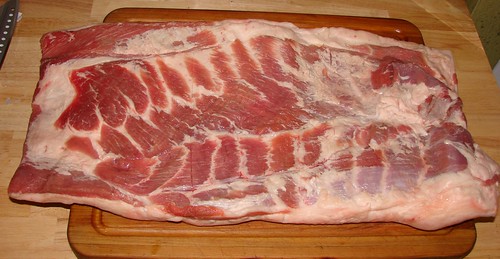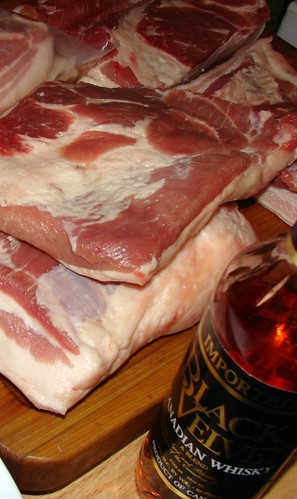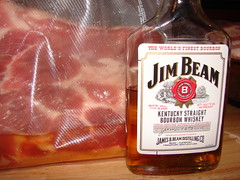I'm always searching for new and exciting ways to prepare my homemade bacon. It occurred to me that marinating the pork in liquor before starting the actual cure would add an extra dimension to the flavor, and one that would be deeper than simply soaking the wood chips in whiskey.
I decided to cure six separate 2-pound slabs of pork: five slabs each with a different liquor and a sixth slab cured without liquor in my standard bacon brine as a control. (The brine recipe can be found at the bottom of this blog entry.)
I decided to cure six separate 2-pound slabs of pork: five slabs each with a different liquor and a sixth slab cured without liquor in my standard bacon brine as a control. (The brine recipe can be found at the bottom of this blog entry.)
 I started off with a beautiful 13-or-so pound pork belly from the local wholesale butcher. I cut it into thirds, and then cut each third in half, winding up with six approximately equal square slabs.
I started off with a beautiful 13-or-so pound pork belly from the local wholesale butcher. I cut it into thirds, and then cut each third in half, winding up with six approximately equal square slabs. Here we see the slabs of pork, cut and ready for the marinade, along with one of the whiskeys used. Although I didn't feel that it was important to use top-shelf premium liquors for the bacon, I also didn't want to use the very cheapest store-brand swill, either. So I selected relatively inexpensive yet reputable national brands:
Here we see the slabs of pork, cut and ready for the marinade, along with one of the whiskeys used. Although I didn't feel that it was important to use top-shelf premium liquors for the bacon, I also didn't want to use the very cheapest store-brand swill, either. So I selected relatively inexpensive yet reputable national brands:- Black Velvet Canadian Whiskey
- Jim Beam Bourbon
- Bacardi White Rum
- Southern Comfort
 I made pouches for my vacuum sealer large enough to accomodate the meat and a couple of cups of liquor. I placed each slab into a pouch, poured in the liquor, then pulled as much of the air out of each pouch as possible before sealing it, so the pork was immersed as much as possible in the liquor.
I made pouches for my vacuum sealer large enough to accomodate the meat and a couple of cups of liquor. I placed each slab into a pouch, poured in the liquor, then pulled as much of the air out of each pouch as possible before sealing it, so the pork was immersed as much as possible in the liquor.Each pouch was labeled after sealing.
I put the pouches into the refrigerator, and turned them every so often to ensure an even marinade. They stayed in the fridge for two days.
At the end of the two-day marinade I opened the pouches, poured off most of the liquor (leaving some behind for flavor) and added enough standard brine to completely submerge the slab. Then I resealed them and refrigerated the pork again to cure.
 Seven days later, I drained and dried each of the slabs, and stuck them with toothpicks so I could tell them apart. In the picture on the left, they're all loaded into the smoker and have just started to smoke. You can see the toothpicks sticking out of the meat.
Seven days later, I drained and dried each of the slabs, and stuck them with toothpicks so I could tell them apart. In the picture on the left, they're all loaded into the smoker and have just started to smoke. You can see the toothpicks sticking out of the meat.I held them over the smoke for a little more than two hours at 250 degrees F and they turned out fantastic! After allowing the bacons to cool somewhat, my wife and daughter joined me for a tasting. The results:
- The Canadian Whiskey with standard cure has a hint of whiskey and caramel, but there isn't a lot of difference between this one and the control - certainly not enough of a difference to justify the added expense.
- The Canadian Whiskey with the maple sugar cure is a lot nicer. A bit sweet, but pleasantly so; the caramel overtones in the whiskey complimented and accented the maple and made this cure much more worthwhile than the plain Canadian.
- The Rum-cured bacon is delicious, one of the best bacons I have ever had. The rum flavor held up beautifully to the cure and the smoke; one of our favorites.
- The Bourbon also stood up well to the smoke and the cure, and delivered a rich, full bourbon flavor with delicious hints of vanilla and caramel. Another favorite, and another cure I will happily use again.
- Southern Comfort gave me the most surprising results, because I really don't like the stuff to drink. None of the faintly citrus notes survived the cure or the smoke, but the bacon has a wonderful whiskey flavor accented with toasted cane sugar reminiscent of cotton candy. It's quite good, and as a result I'd be happy to make this variety of bacon again. Good thing, too, because somehow I've managed to acquire two bottles of Southern Comfort, and I have no intention ever to drink the nasty stuff.
A note about the smoke:
Most of the time, I smoke bacon over hickory or apple chips, sometimes adding a bit of mesquite for the touch of "spiciness" it lends. This time, though, I used chips packaged by "Charmglow" which were labeled as being "oak whiskey barrel chips." Although there might be some old oak whiskey barrel chips in the bag, they were thoroughly adulterated with hickory and mesquite. I was disappointed because my intention was to make whiskey-cured bacon smoked over whiskey-barrel chips, but at least the smoke was flavorful and the final results were good.
If you've been grilling for a long time, you might remember Charmglow as the manufacturers of rugged gas grills that lasted seemingly forever. Well, you can lose that notion right now. Home Depot has owned the name since 2004, and the grills are now shoddy low-end things made in China by the lowest bidder.
I like to use brine to cure my homemade bacon because I hot-smoke it, turning out a Russian-style bacon that can be eaten chilled as is, or sliced and further cooked. Brine-cured bacon retains more moisture and holds up to the hot smoking process better than dry rubbed cures, which draw moisture out of the pork.
It's also a convenient way to cure bacon during the summer. In the winter, I can hang meats to cure in my attic - it stays cold up there, and the humidity is fairly constant. In the summer, that's not an option, so brine cures in the fridge are the only way to go for me.
Dave's Standard Bacon Brine
1 gallon water
1 cup kosher salt
1/2 cup brown sugar
1 tsp Morton TenderQuick
Mix thoroughly until everything is dissolved; submerge pork in solution for 4 to 8 days.
One of the nicest things about this brine is its versatility. Experiment with it by adding mustard seed, cracked black peppers, bay leaves, sprigs of fresh thyme, or sliced garlic. The flavors will surprise you, and the bacon you make will be sought-after by family and friends.
Dave's Standard Bacon Brine
1 gallon water
1 cup kosher salt
1/2 cup brown sugar
1 tsp Morton TenderQuick
Mix thoroughly until everything is dissolved; submerge pork in solution for 4 to 8 days.
One of the nicest things about this brine is its versatility. Experiment with it by adding mustard seed, cracked black peppers, bay leaves, sprigs of fresh thyme, or sliced garlic. The flavors will surprise you, and the bacon you make will be sought-after by family and friends.

I love how Bacon-centric you are. Makes me want to make a trip to Connecticut and knock on your door.
ReplyDeletebe still my beating heart--as I'm sure it would be after eating this! Dear God, I love pork and this looks fantastic!
ReplyDelete"tarted off with a beautiful 13-or-so pound pork belly from the local wholesale butcher."
ReplyDeleteI'm in your area. Where are you buying nice belly? The only belly I've found so far is from Arnolds and it was quite thin at best.
Anonymous - Go to 90 Meat Market, on Avocado Street in Springfield (it's in the North End, head toward West Springfield and it's on the left just before you hit the North End Bridge.)
ReplyDeleteTheir phone number is (413)737-1288. If you're making a special trip to buy bellies, CALL THEM before you go to make sure they're in stock - sometimes they run out and it can be a few days before more comes in.
Also: When you buy it, they'll ask you if you want it bone in or boneless. I always get it with the bone and trim it out myself. The bellies are thicker and meatier with the bone it, and so I do my own trimming and use the ribs for other purposes.
Dave, Thanks for the tip about 90 Meat Market. I had bought a couple of ribeye roasts from them a while back and wasn't really happy but if they have full belly's like that it's worth another try! How difficult is it to separate the ribs from the belly? While I'm trying to improve my butchering skills are sad at best! Any recollection of what you paid per pound? Thanks!
ReplyDeleteAnonymous: Use a long boning knife or filleting knife. Put the belly bone-side up on a cutting board and begin with the blade of the knife flat against the bottom of the rib bones. Using long, smooth strokes, free the bones from the belly and lift them up and away - they'll look like a rack of spare ribs. You can cure them with the bacon or cook them as is. I like to marinate them in teriyaki sauce and grill them.
ReplyDeleteI think the last time I bought bellies there they ran me about $1.99 a pound. You don't really save any money by making your own bacon once you consider the cure ingredients, the time, the meat cost, and so on - but you sure do get a better product.
P.S. Saturday is the worst day of the week to go to 90 Meat. The place is jammed, the meat cutters are stressed with everyone wanting their stuff trimmed and cut, and they run out of stuff. Go in the middle of the week after work if you can.
Dave,
ReplyDeleteI have been thinking of doing this for a while now. This sounds excellent. What about using beer? Does carbonation have an effect on the pork? I'm new to curing and I'm trying to avoid that pesky food poisoning. Or worse ruining a perfectly good piece of pork. Any suggestions would be greatly appreciated.
Jesse, I don't see any reason why using beer in the cure wouldn't work. Most beers are pasteurized, so I don't think there would be a problem with bacteria, and you'd still have the salt and sugar as well. Pork and beer are natural companions. What type are you thinking of using?
ReplyDeleteWell, there are a lot of nice micro-brews here in Minneapolis but I think I'd like to try a good ole fashioned Guinness. Tough to improve on perfection.
ReplyDeleteHow much of each of the alcohols did you add before vacuum sealing?
ReplyDeleteChris V - I poured in about a cup and a half, but I didn't use vacuum to seal the bags, just the heat to make pouches.
ReplyDeleteHi Dave. I've only used dry rubs for curing, but would like to try your brine technique. Can I use a food-quality plastic pail with a locking lid to brine multiple bellies at the same time? What do you normally use as a container for brining pork bellies?
ReplyDeleteMark C. - Yes, you can use food-grade plastic containers for a brine cure. You can use anything that is non-reactive, i.e. food-grade plastic, stainless steel, enamel-covered cookware, and so on. No cast iron, carbon steel, aluminum, or anything like that.
ReplyDeleteI have used plastic tubs and also coolers lined with food-grade plastic, but recently I've been using heat-sealed plastic with a Foodsaver vacuum sealer. I use the heat with no vacuum to seal the bags.
Greetings Smoke Master:
ReplyDeleteEnjoyed your site. I have been making cured and smoked products for many years as my family (Italians) have since 1541 in a town in Italy called Cavassagra. I want to add to your comments on cures and bacon's. Last year we made over 100 lbs of bacon and 400 lbs of cured, air dried product, (salami, capicolo, spalla, lonza, and pancetta), and enjoy curing with liquors and wines. Hands down the best bacon recipe I came up with is 10 lbs of pork belly, 4 tbs of #1 cure, (bacon takes more cure than the 1tsp for 5 lbs), 1/3 cup of dark brown sugar, 3 heaping tbs of minced garlic, and 1 cup salt. Now here is the kicker: 12 ozof sweet vermouth and 4 oz of Southern Comfort. 5 days in the fridge curing (a day more for 2" + bellies) then 4 hours of smoke at 135-140 degrees. Finish at 200 till 162 degrees internal meat temp. Total 10 hours. I have had this stuff in the fridge for a year vac sealed and never lost a piece. Great taste and browns fast in the oven or pan. 250 degrees for 12 mins at a thick slice #4 on my slicer. Excellent.
I am starting some lonza today (pork loin) in a cure of dark rum with orange rind and other spices. I will take the advise you gave to use the rum for the first few days exclusively before I start the cure. Great idea. Then I will mix the cure and finish it the next 20 days in that. Then I dry for 40 days (till -30% takes place)before we slice to eat. We do have some of this (different mix, olive oil and black pepper) that is still hanging at 8 months old. Super buttery when sliced so that it only has one side. Well that's my post. Hope you all enjoy.....
Living the life in Tn.
J&E in Tn